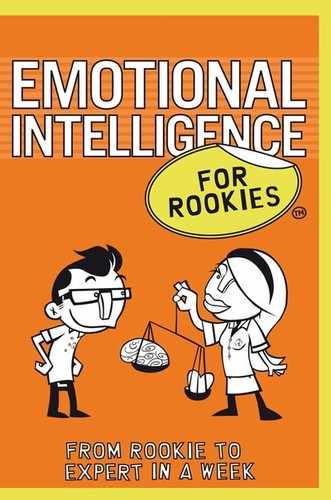Index
adoption model for emotional intelligence 195–6
amygdala 13
behaviour, effect on others 46–7
body-temperature cycle 91–2
bouncing back see emotional resilience
brain, frontal 12
brain, mid 12, 13; see also limbic system
brain functions, understanding 12–13
breathing, controlling 27, 79–81
Broughton, Richard 163
CardioSense Trainer (CST) 208
circadian rhythm 91–2
clients, understanding 18
cognitive intelligence 9, 10–11, 13–15
comfort zone, working outside 73
communication building trust through 122–3, 124
through connection 126
through factual exchange 125
through feelings 126
through ideas and opinions 125–6
through ritual and cliché 124
concentration, losing 97
congruency 183
connection in communication 126–7
conscientiousness 38
assessing 177–8
definition of 173, 174
effect on others 182–3
factors affecting 179–82
importance of 174–5, 176–7
consistency, achieving 186–7
courage, effect on self-awareness 49
crisis management 70–71
criticism, accepting 83, 208
cross-cultural working 19
curiosity, effect on selfawareness 50
Damasio, Antonia 25
distracting thoughts, elimination of 102
distractions, eliminating 116
Dulewicz, Victor 9, 44, 65, 87, 108, 134, 157, 173
EI see emotional intelligence emotion, definition of 24–5
emotional feelings 28
emotional intelligence 10–11, 13–15
adopting 195–9
definition of 7–8
Energy Generator 3, 38–9
framework, Higgs & Dulewicz 3, 38
importance of 15–16
integrating into one’s life 195, 200–201
questionnaire 3, 78, 99, 121, 148, 164, 185, 200
self-perception questionnaire 35, 36–8, 53, 54, 77, 98, 120, 147, 163, 184
emotional resilience 65–83, 77–8, 346
definition of 65–6
effect on others 75–6
factors affecting 73
importance of 68
low 69–70
strengthening 76, 77–8, 83
emotional state, managing 88
emotional states, learning about 43–4
emotions
being overcome by 67–8
effect on others 29
facial expressions and 26
self-expression and 141–2
use of 26
using to exert control 33–4
emotions diary 53, 77, 99, 121, 147, 184
keeping an 54–6
empathetic climate, building an 114–29
empathy 107
energy 89–96
creating 90
harnessing 100–101
importance of 89
managing 91–2
energy levels, maintaining 93–4
environment, creating the right 143–4
exercise, importance of 93
expectations
discussion of with colleagues 181–2
managing 182
factual exchanges in communication 125
feedback 13, 60, 83, 121, 195, 201, 206
asking for 48, 49, 50, 53, 54, 60, 78, 99, 121, 148, 164, 175, 185, 197, 206
value of 4
feelings 27–8
controlling 81
emotional 28
encouraging others to share 150
in communication 126
intuitive 28
physiological 27, 31
sharing 149
feelings-based conversation 149
flexible approach, adopting a 142–3
Gardner, Howard 9
Gigerenzer, Gerd 161–2
goals, visualizing 102
Goleman, Daniel 9, 11
health, emotions and 32–3
Higgs & Dulewicz emotional intelligence framework 3, 38
Higgs & Dulewicz Seven Elements of Emotional Intelligence 4
Higgs, Malcolm 9, 44, 65, 87, 108, 134, 157, 173
hijack, emotional 67–8
honesty, effect on self-awareness 49
ideas and opinions in communication 125–6
incongruent feelings, dealing with 176
industrial change, effects on individuals 16
influence
assessing own 136–8
definition of 134–5
effect on others 143–4
exerting over others 133–53
factors affecting 139
importance of 135–6
use of language in 145–7
Ingram, Harry 205
inner voice see intuition; intuitiveness
insight into others’ feelings, gaining 150–51
inspiring others 194
integration model for emotional intelligence 195, 200–201
integrity, personal 174
intelligence quotient see IQ
internal chatter 57, 59
interpersonal intelligence, 7, 9, 10, 15
interpersonal relationships 107–29
interpersonal sensitivity 37, 108
effect on others 120–22
importance of 108–9
influences on 110–12
intrapersonal intelligence 7, 9–10, 15
intuition 72
trusting 19, 157–69
intuitive feelings 28, 72
intuitiveness 38
assessing 165–6
awareness of 166–7
balancing with logic 162–3
definition of 157
factors affecting 159–60
freeing 167–8
importance of 158–9
IQ tests 10–11
Johari Window template 53, 54, 78, 99, 121, 122, 147, 148, 164, 165, 185, 205–7
knowing yourself 43–54
language, using to influence 145–7
laughter, value of 34
leading colleagues 153
limbic system 12, 13, 13–14, 15, 34, 75
listening 114–15
importance of 114, 129
listening, patience and 116
logic and intuitiveness 162–3
Luft, Joseph 205
Meyer, Jack 9, 25
mood 29–30, 34
motivation 37, 87–102
effect on others 98
negative emotions 29–30, 32, 33, 44, 55, 57, 59, 66, 67, 71, 96, 141
minimizing 56
neo-cortex 12
networking 123
“no”, ability to say 80–81
non-verbal signals 141–2
obstacles, overcoming 97
organizational change, effects on individuals 17–18
pacing colleagues 152
patience, importance of in listening 116
perceptions, being aware of 60
personal culture, creating 193–201
personal behaviour, effect on others 46–7
personal development 79–82, 100–102, 122–9, 149, 165–8, 186–8
achieving 54
personal goals, defining 95–7
physiological feelings 27, 31
physiological responses to emotional stimuli 23–4
physiological signals of pressure 72
physiology, emotions and 31–2, 34
positive emotions 28, 94, 95, 141–2
maximizing 57–8
posture, importance of 93–4
preparing for the unexpected 81–2
pressure dealing with 71
physiological signals of 72
working under 74
pride 29
questionnaire 3, 78, 99, 121, 148, 164, 185, 200
self-perception questionnaire 35, 36–8, 53, 54, 77, 98, 120, 147, 163, 184
rapport
developing in an existing relationship 127–9
establishing 110–11
establishing through communication 122–9
using 140
relationship management 9–10, 18–19
relationships 107
building 109
resourcefulness, achieving 56
respect, earning 144–5
responsibility for mistakes, taking 75
ritual and cliché in communication 124
role model, becoming a 189
Salovy, Peter 9
self-awareness achieving 53
definition of 44–6
effect on others 52, 54
importance of 9, 17, 36, 42, 44, 48
influences on 49–50
self-belief, strengthening 58–61
self-belief cycle 59, 60, 61, 70–71
self-management 9–10, 16–18
self-perception questionnaire 35, 36–8, 53, 54, 77, 98, 120, 147, 163, 184
Seven Elements of Emotional Intelligence, Higgs & Dulewicz 4
sixth sense see intuition; intuitiveness
strategies for understanding others
asking questions 118
paraphrasing 117
reflecting 117
restating 117
summarizing 117–18
support network, personal 116
technological change, effects on individuals 17
triggers 55–6
trust 107
building 112–13
building through communication 122–3, 124
unexpected, preparing for the 81–2
understanding others 117–18
value and ethics, alignment of 179–80
values, defining one’s own 187–8
visualization 59
willingness to learn, effect on self-awareness 50, 51–2
